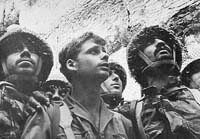One single iconic image depicting the moment of reunification of Jerusalem in 1967 has remained in the world’s collective psyche. Three battle-weary paratroopers gazing at their surroundings seemingly in stunned amazement. With the fortieth anniversary of the Six-Day War, Conal Urquhart of The Observer located and interviewed both the photographer and the three soldiers – there is a link below to the full article.


The Paratroopers…
Zion Karasenti, 64, now a director and choreographer, living in Afula: “At Ammunition Hill, all we could see was a hill surrounded by trenches and barbed wire. When we started to move, they threw everything they had at us. We got through one fence and found more wire. I threw myself on it and acted as a bridge for everyone else. I felt no pain. We got into the trenches, which were shallow and narrow. When someone was injured we passed them down the line over our bodies. The Jordanians couldn’t get away, but they kept on fighting to the last man.
I was the first paratrooper to get to the Wailing Wall. I didn’t know where I was, but I saw a female Israeli soldier, so I asked ‘Where am I?’ and she said: ‘The Wailing Wall.’ She gave me a postcard and told me to write to my parents before she disappeared. It might have been a dream, but then many years later I met the woman. She had been in the postal corps.
As more soldiers arrived, a photographer told us to stand like this and look in this direction. I just did it – I didn’t even think about it.
When I think of all the soldiers that died to take Jerusalem, I wonder if they would have thought it was worth it. I think they would.”
Yitzak Yifat, 64, now an obstetrics and gynaecology surgeon: “I developed toothache when we arrived in Jerusalem and went into battle with my mouth still numb from the local anaesthetic. It was face-to-face fighting. I fought like a tiger. My friend was shot in the backside and he was about to be shot again by a Jordanian. I shot him. Another Jordanian saw I was out of bullets and he charged at me with a bayonet. I don’t know how I did it, but I took his gun and shot him with it. It was brutal, and a sad victory. I lost many friends. After the fighting we built a memorial to our friends – and one to the Jordanians, in honour of their bravery.”
Haim Oshri, 63, emigrated from Yemen to Israel in 1949: “The battle for Ammunition Hill was the worst moment of the war. There wasn’t a plan – we were just told to attack. The Jordanians were brave soldiers. Now it makes me angry to think of all the unnecessary casualties. If we had taken more time to plan, there would have been far fewer casualties.
As an Orthodox Jew it was special for me to be involved in the fight for Jerusalem. It doesn’t matter if you’re from Poland or Yemen, Jerusalem is our common bond. Every day we pray three times to Jerusalem, and I could never have imagined the magic of seeing the Kotel [Western Wall] for the first time.”
The photographer…
Viennese born, David Rubinger had served with the British Army in the Second World War, emigrating to Palestine in 1939. By 1967 he was working for Life magazine, covering Israel’s invasion of the Sinai. When he realized Israel planned to liberate Jerusalem he rushed back, arriving at the Western Wall in time to take the first photos of Israeli soldiers at the holy site.
“Things began to heat up in May 1967 and I went to join the Israeli forces in the Negev. A few days before war broke out everything seemed to go quiet. I had dinner in Tel Aviv with a colleague, Paul Schutzer from Life magazine. We bet a bottle of champagne on who would get the first cover photograph. The war broke out on the Monday and Paul was killed the same day.
I was with the Israeli forces that went into the Sinai. Just after the battle for El Arish, I overheard radio messages that something was going to happen in Jerusalem. A helicopter was taking away the wounded so I squeezed on. I didn’t know where it was going, but it landed in Beersheva, where I’d parked my car.
I was exhausted. I never trust anyone to drive my car, but I picked up a soldier who was hitchhiking and got him to drive while I slept. We arrived at 6am in Jerusalem and I went straight to see my family. I found out that Jerusalem had been taken and I headed for the Old City. I didn’t have any great feeling for Jerusalem, I just wanted to be the first with the photographs. There was still some sniping going on but the fighting was over. When I got there, it was very emotional. Everyone around me was crying.”
When I developed the film, I didn’t think much of the picture
“I think there was such euphoria because in the weeks before the war there was a sense of doom. The national stadium was prepared for 40,000 graves and even if we thought we might win, it would be a costly victory. The humour before the war was very dark. ‘Would the last person to leave please turn out the lights.’
We went from being doomed to having an empire. It was like a condemned man with the noose around his neck suddenly being told that not only was he going to live, he was going to be the king. The nation went a little nuts. For the religious, the victory had to be God-given and that is how the whole Jewish messianic and settler movement was born.
I lay down to take the picture of the paratroopers because there was barely three metres between the Wailing Wall and the houses next to it. When I developed the film, I didn’t think much of the picture. I gave it to the army. They passed it on to the government press office which then distributed it to everyone for virtually nothing. I still don’t think it’s a great picture, but often iconic pictures are created by the media and what people read into them.”
| Analysis – from Digital Journalist site: “Shots were still being fired. Soldiers cried and so did Rubinger. He claims he was lying on the ground, photographing upwards, because he was scared. I refuse to believe that. Fear has not stopped him from running under fire on other occasions. He is not ashamed of the fear, but of the fact that at that historical moment he sought and found the correct angle. He had to lie down to photograph what seemed right.
This photograph connects the old and the new, hope with stones that have been bled. Changing the angle might have separated the soldiers from the Wall. There is smiling and weeping, a helmet held in awe. This is the story of the war, what it did and will still do, where it came from and where it will still go. It is a moment plucked from the flight of time, but also powerful and accurate documentation of an event full of surprises – because it is a frozen moment.”– Yoram Kaniuk |


